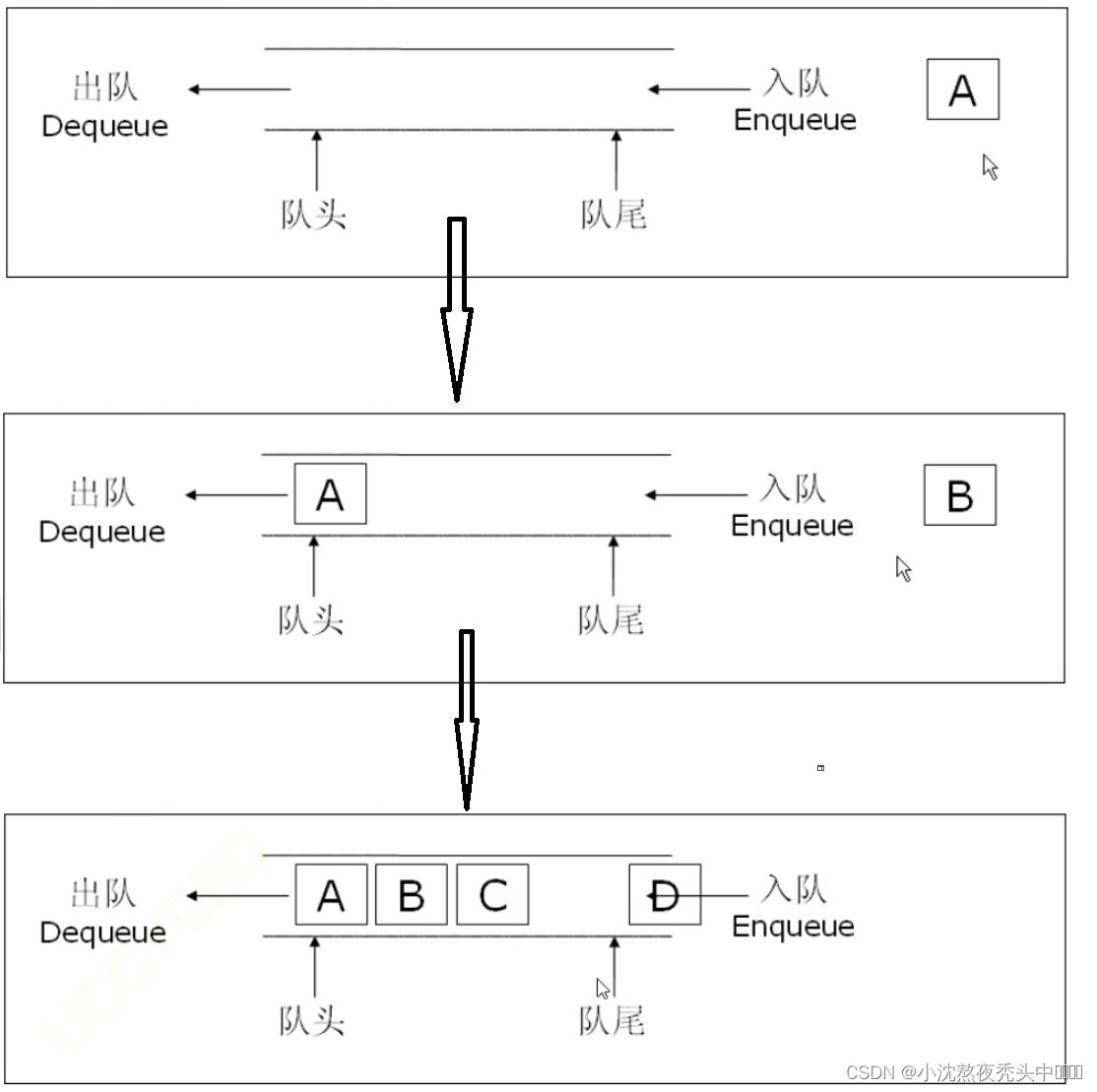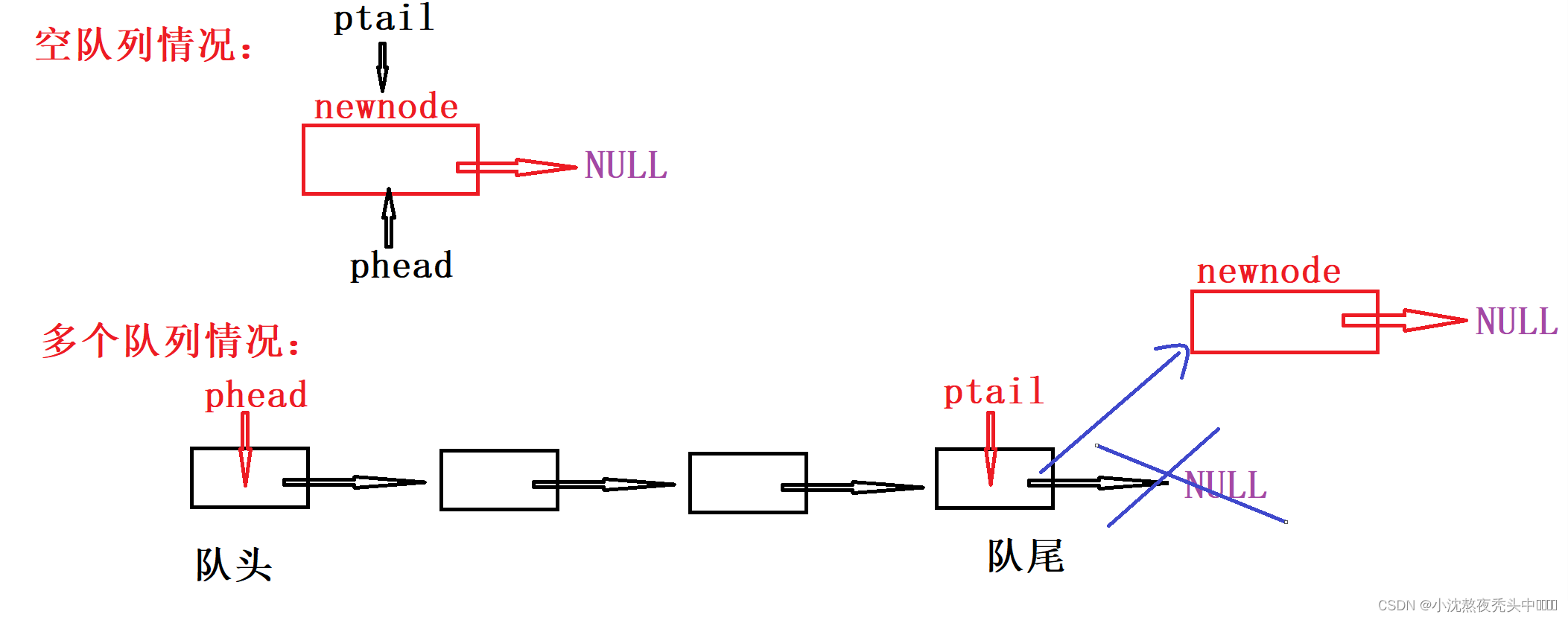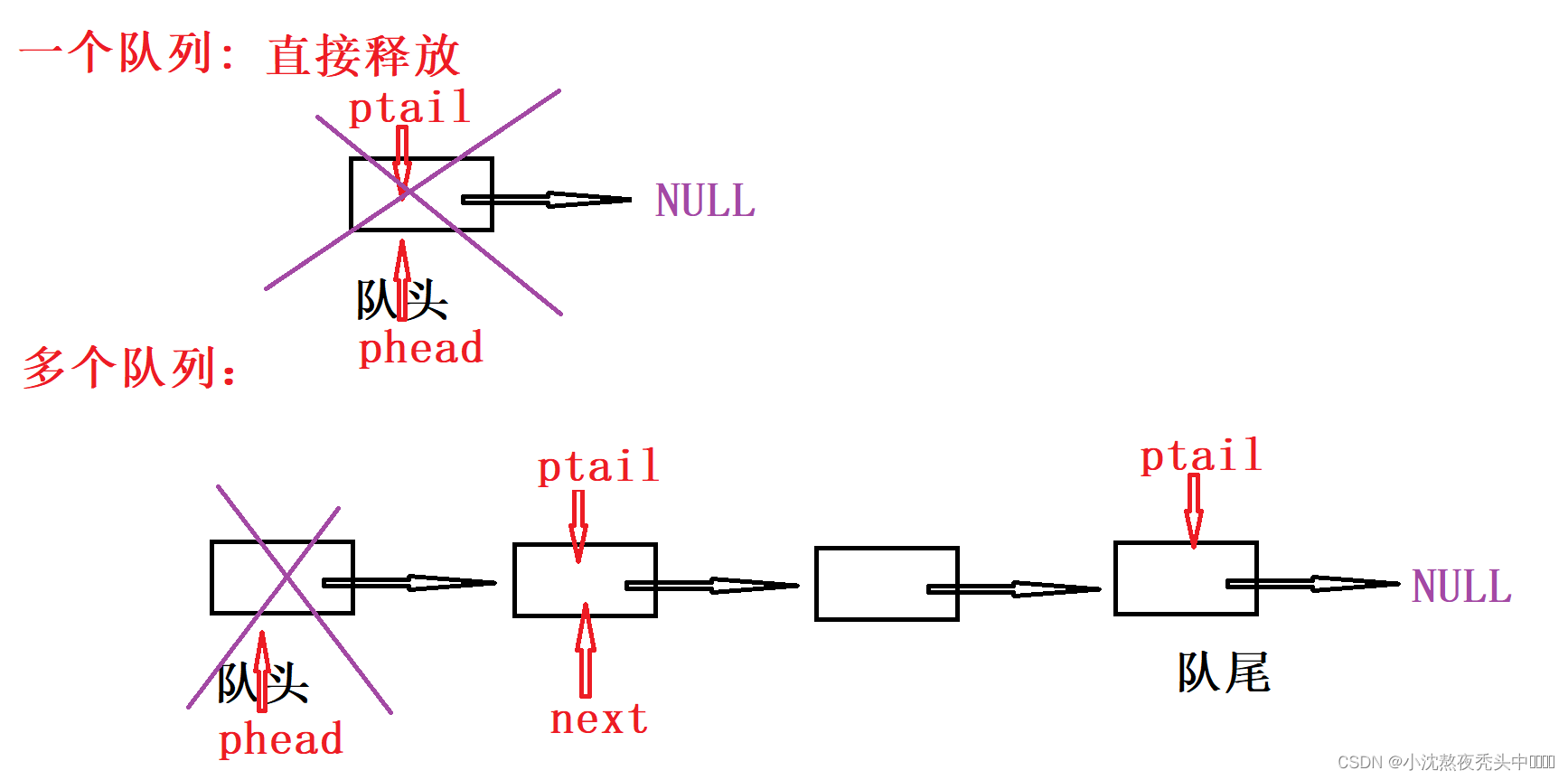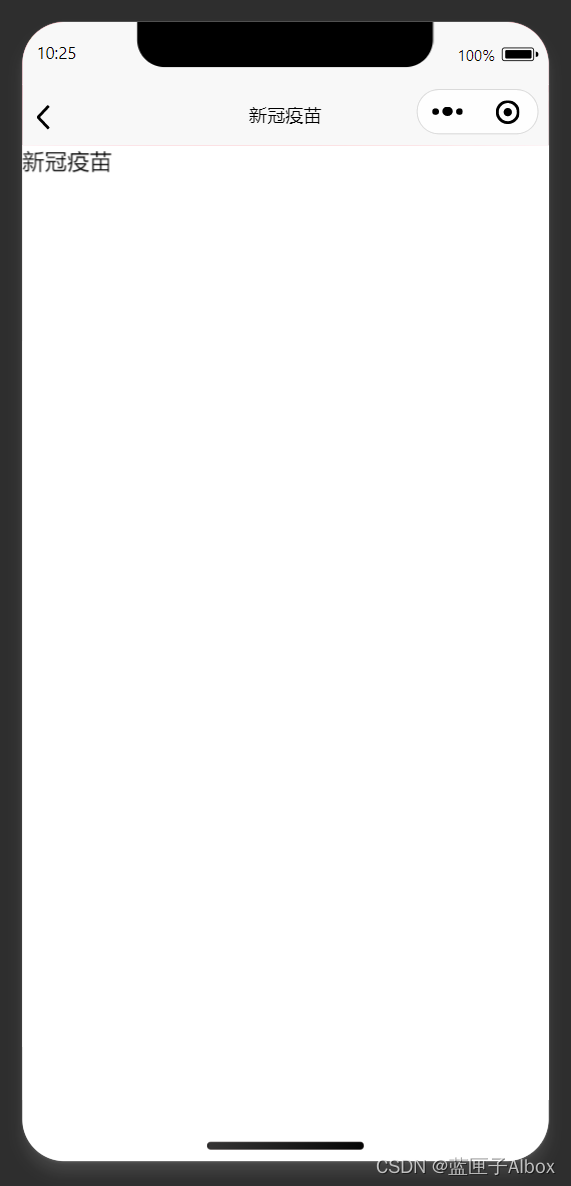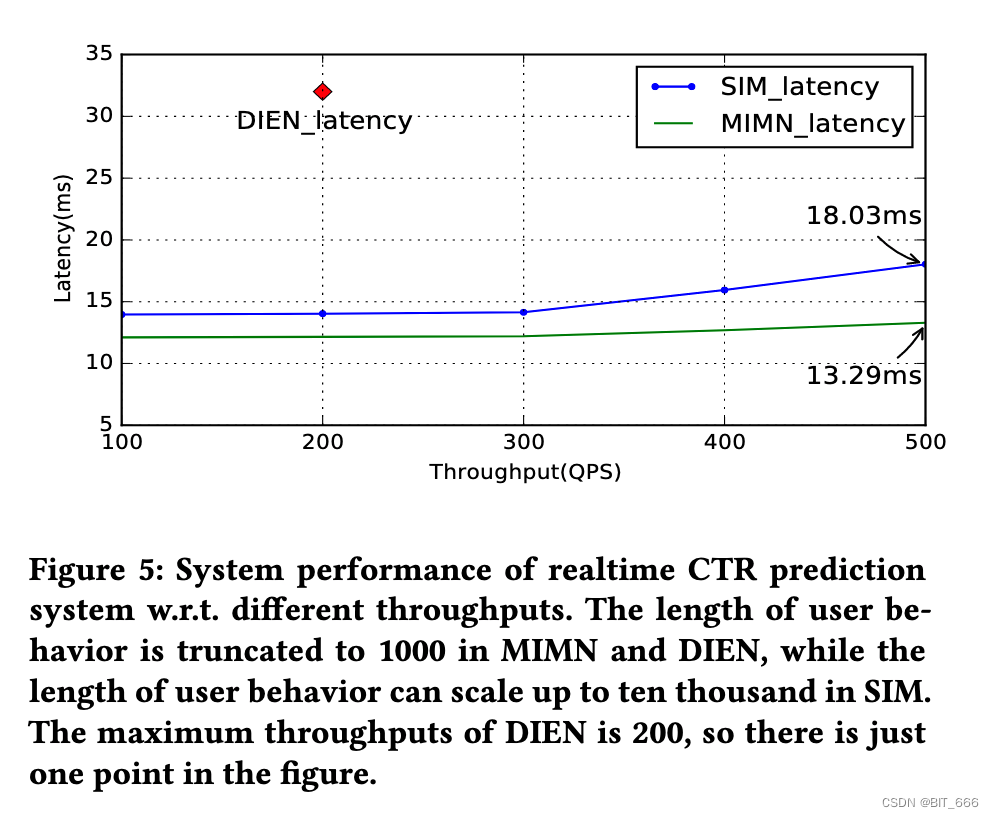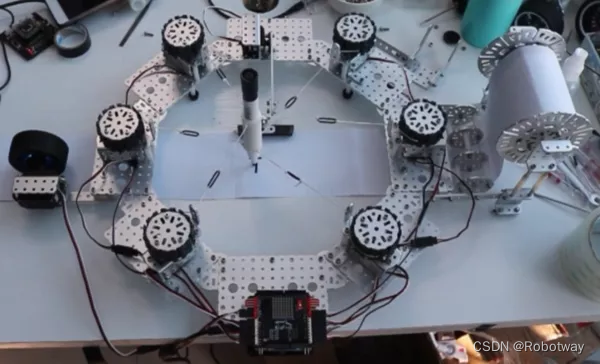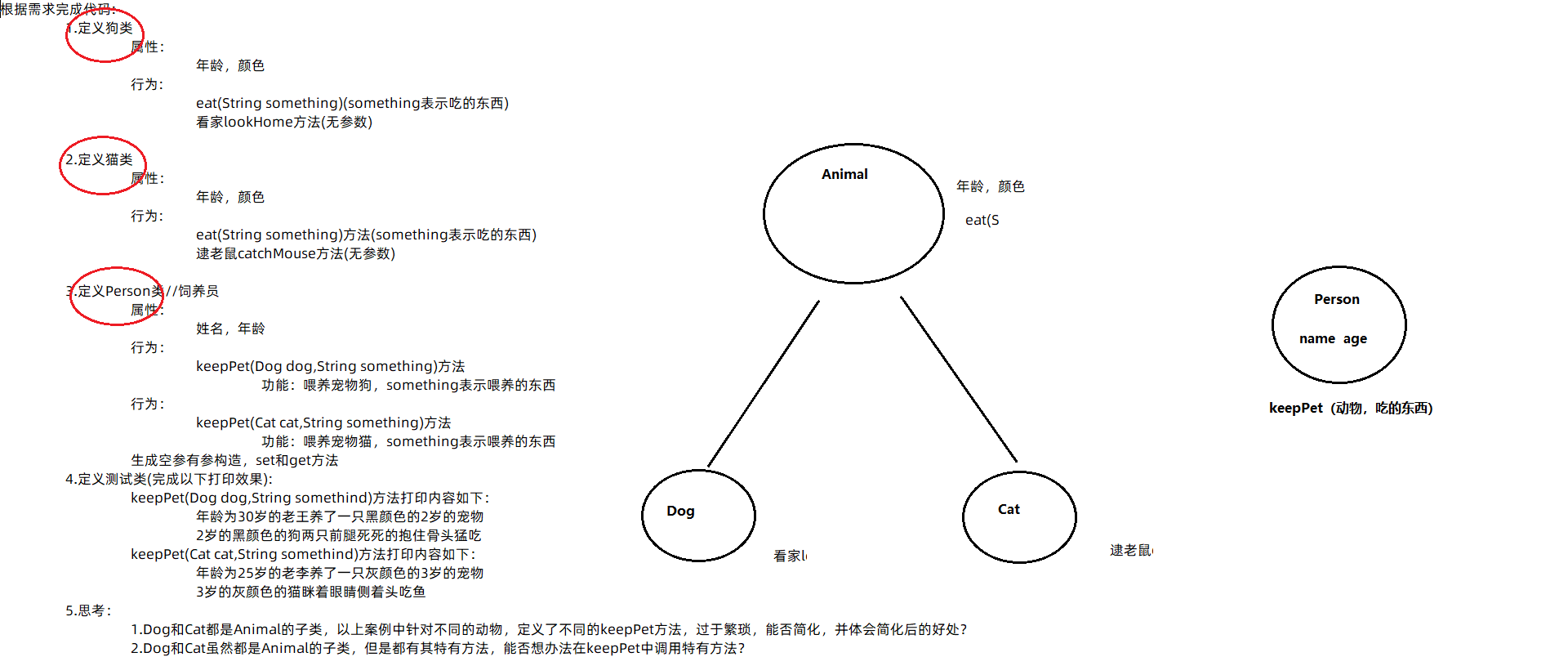文章目录
- 前言
- 🌟一、队列的概念及结构:
- 🌟二、队列实现的两种方式:
- 🌟三、队列的实现:
- 🌏3.1队列结构:
- 🌏3.2初始化:
- 🌏3.3释放(类似单链表):
- 💫3.3.1代码:
- 💫3.3.2流程图:
- 🌏3.4入队(类似单链表尾插):
- 💫3.4.1代码:
- 💫3.4.2流程图:
- 🌏3.5出队(类似单链表头删):
- 💫3.5.1代码:
- 💫3.5.2流程图:
- 🌏3.6队头数据:
- 🌏3.7队尾数据:
- 🌏3.8数据个数:
- 🌏3.9判空:
- 🌟四、完整代码:
- 😽总结
前言
👧个人主页:@小沈熬夜秃头中୧⍤⃝❅
😚小编介绍:欢迎来到我的乱七八糟小星球🌝
📋专栏:数据结构
🔑本章内容:[数据结构]—栈和队列
送给各位💌:各花各有各花香 同致之人才懂一片风景
欢迎 评论📝 +点赞👍 +收藏😽 +关注💞哦~
提示:以下是本篇文章正文内容,下面案例可供参考
🌟一、队列的概念及结构:
队列:只允许在一端进行插入数据操作,在另一端进行删除数据操作的特殊线性表,***队列具有先进先出FIFO(First In First Out)***
入队列:进行插入操作的一端称为队尾
出队列:进行删除操作的一端称为队头
🌟二、队列实现的两种方式:
- 数组队列
- 链式队列
🌟三、队列的实现:
🌏3.1队列结构:
需要定义两个结构体,一个是整个队列中每个节点的结构一个是队头指针、队尾指针和数据个数
typedef int QDataType;
typedef struct QUeueNode//每个节点的结构
{
struct QueueNode* next;
QDataType data;
}QNode;
typedef struct Queue
{
QNode* phead;
QNode* ptail;
int size;
}Queue;
//初始化
void QueueInit(Queue*pq);
//释放
void QueueDestroy(Queue* pq);
//尾插(入队)
void QueuePush(Queue* pq,QDataType x);
//头删(出队)
void QueuePop(Queue* pq);
//队头数据
QDataType QueueFront(Queue* pq);
//队尾数据
QDataType QueueBack(Queue* pq);
//数据个数
int QueueSize(Queue* pq);
//判空
bool QueueEmpty(Queue* pq);
🌏3.2初始化:
void QueueInit(Queue* pq)
{
assert(pq);
pq->phead = NULL;
pq->ptail = NULL;
pq->size = 0;
}
🌏3.3释放(类似单链表):
💫3.3.1代码:
void QueueDestroy(Queue* pq)
{
assert(pq);
QNode* cur = pq->phead;
while (cur)
{
QNode* next = cur->next;
free(cur);
cur = next;
}
pq->phead = pq->ptail = NULL;
pq->size = 0;
}
💫3.3.2流程图:
🌏3.4入队(类似单链表尾插):
💫3.4.1代码:
void QueuePush(Queue* pq, QDataType x)
{
assert(pq);
QNode* newnode = (QNode*)malloc(sizeof(QNode));
if (newnode == NULL)
{
perror("malloc fail");
return;
}
newnode->data = x;
newnode->next = NULL;
if (pq->ptail == NULL)
{
assert(pq->phead==NULL);
pq->phead = pq->ptail = newnode;
}
else
{
pq->ptail->next = newnode;
pq->ptail = newnode;
}
pq->size++;
}
💫3.4.2流程图:
🌏3.5出队(类似单链表头删):
💫3.5.1代码:
void QueuePop(Queue* pq)
{
assert(pq);
assert(!QueueEmpty(pq));//这里是判断pq->phead不为空
//一个队列
if (pq->phead->next == NULL)
{
free(pq->phead);
pq->phead = NULL;
pq->ptail = NULL;
}
//多个队列
else
{
QNode* next = pq->phead->next;
free(pq->phead);
pq->phead = next;
}
pq->size--;
}
💫3.5.2流程图:
🌏3.6队头数据:
QDataType QueueFront(Queue* pq)
{
assert(pq);
assert(!QueueEmpty(pq));
return pq->phead->data;
}
🌏3.7队尾数据:
QDataType QueueBack(Queue* pq)
{
assert(pq);
assert(!QueueEmpty(pq));
return pq->ptail->data;
}
🌏3.8数据个数:
int QueueSize(Queue* pq)
{
assert(pq);
return pq->size;
}
🌏3.9判空:
bool QueueEmpty(Queue* pq)
{
assert(pq);
return pq->size==0;
}
🌟四、完整代码:
//Queue.h
#define _CRT_SECURE_NO_WARNINGS 1
#include<stdio.h>
#include<assert.h>
#include<stdbool.h>
#include<stdlib.h>
typedef int QDataType;
typedef struct QUeueNode//每个节点的结构
{
struct QueueNode* next;
QDataType data;
}QNode;
typedef struct Queue
{
QNode* phead;
QNode* ptail;
int size;
}Queue;
//初始化
void QueueInit(Queue*pq);
//释放
void QueueDestroy(Queue* pq);
//尾插(入队)
void QueuePush(Queue* pq,QDataType x);
//头删(出队)
void QueuePop(Queue* pq);
//队头数据
QDataType QueueFront(Queue* pq);
//队尾数据
QDataType QueueBack(Queue* pq);
//数据个数
int QueueSize(Queue* pq);
//判空
bool QueueEmpty(Queue* pq);
//Queue.c
#define _CRT_SECURE_NO_WARNINGS 1
#include"Queue.h"
void QueueInit(Queue* pq)
{
assert(pq);
pq->phead = NULL;
pq->ptail = NULL;
pq->size = 0;
}
void QueueDestroy(Queue* pq)
{
assert(pq);
QNode* cur = pq->phead;
while (cur)
{
QNode* next = cur->next;
free(cur);
cur = next;
}
pq->phead = pq->ptail = NULL;
pq->size = 0;
}
void QueuePush(Queue* pq, QDataType x)
{
assert(pq);
QNode* newnode = (QNode*)malloc(sizeof(QNode));
if (newnode == NULL)
{
perror("malloc fail");
return;
}
newnode->data = x;
newnode->next = NULL;
if (pq->ptail == NULL)
{
assert(pq->phead==NULL);
pq->phead = pq->ptail = newnode;
}
else
{
pq->ptail->next = newnode;
pq->ptail = newnode;
}
pq->size++;
}
void QueuePop(Queue* pq)
{
assert(pq);
assert(!QueueEmpty(pq));
//一个队列
if (pq->phead->next == NULL)
{
free(pq->phead);
pq->phead = NULL;
pq->ptail = NULL;
}
//多个队列
else
{
QNode* next = pq->phead->next;
free(pq->phead);
pq->phead = next;
}
pq->size--;
}
QDataType QueueFront(Queue* pq)
{
assert(pq);
assert(!QueueEmpty(pq));
return pq->phead->data;
}
QDataType QueueBack(Queue* pq)
{
assert(pq);
assert(!QueueEmpty(pq));
return pq->ptail->data;
}
int QueueSize(Queue* pq)
{
assert(pq);
return pq->size;
}
bool QueueEmpty(Queue* pq)
{
assert(pq);
return pq->size==0;
}
//Test.c
#define _CRT_SECURE_NO_WARNINGS 1
#include"Queue.h"
void TestQueue()
{
Queue q;
QueueInit(&q);
QueuePush(&q, 1);
QueuePush(&q, 2);
QueuePush(&q, 3);
QueuePush(&q, 4);
while (!QueueEmpty(&q))
{
printf("%d ", QueueFront(&q));
QueuePop(&q);
}
printf("\n");
QueueDestroy(&q);
}
int main()
{
TestQueue();
return 0;
}
😽总结
😽Ending,今天的栈和队列(下)的内容就到此结束啦~,如果后续想了解更多,就请关注我吧,一键三连哦 ~

